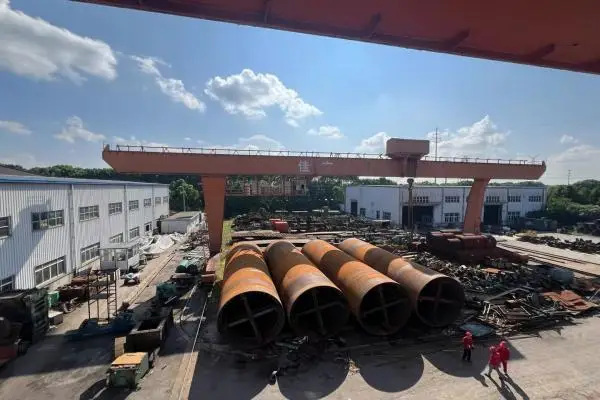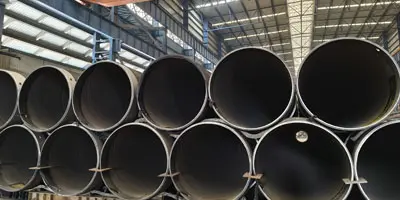Steel piles are widely used in developed countries, yet their adoption in China remains limited. This situation arises due to differences in construction practices, local conditions, and equipment availability. However, the benefits of steel piles, especially for earthquake-resistant structures, cannot be overlooked.
What Are Steel Pipe Piles?
Steel pipe piles are structural elements used in construction to provide foundational support. Made from high-strength steel, these piles are driven deep into the ground to transfer structural loads to stable soil layers or bedrock. There are several types of steel pipe piles, each with unique properties designed for specific applications. Below, we delve into the main types, including, H-section steel piles, spiral welded piles, electric resistance welded (ERW) piles, and composite piles.
H-Section Steel Piles
H-section steel piles feature a cross-sectional shape resembling the letter "H." Their wide flange and flat profile allow for superior load distribution and deep penetration into tough soils. These piles perform exceptionally well in seismic areas, as their flexible structure absorbs horizontal forces, providing excellent earthquake resistance. They are widely used for bridge foundations, retaining walls, and industrial facilities.
Steel pipe piles, also including spiral welded piles, ERW piles and composite piles, offer strength, durability and versatility. Spiral welded piles are cost-effective for marine and infrastructure projects. ERW piles are smooth and ideal for residential and light industrial use. Composite piles combine steel with concrete or coatings to provide additional strength and corrosion resistance for special environments.

Why Steel Pipe Piles Are Ideal for Earthquake-Prone Areas
Some experts say that many buildings in Japan are flexible structures. This statement should include two aspects: one is that the foundation of the building is flexible (steel piles), and the other is that the superstructure is flexible (steel structure or other composite flexible material structure). However, from the perspective of vibration reduction, the flexible structure of the foundation is more important. The earth is the source of excitation, and the piles are the shock absorbers. It doesn't matter if the upper building is a rigid body, because the vibration intensity of the rigid body depends entirely on the shock absorber. The earthquake resistance of Japanese buildings is world-renowned, and its successful experience is worth learning from.
Using H-shaped steel as the foundation pile of the building does not increase the cost much, but it increases the safety a lot. It is like using a huge steel nail to firmly fix the ground building in the foundation, which gives the general public enough sense of security psychologically. As long as the H-shaped steel piles with correct specifications and regular manufacturers enter the ground from the specified pile position on the ground, there is no need to worry about any other quality problems. As for what kind of safe form the superstructure of the building adopts, it will be solved by experts and scholars in other fields.
An academician of the Chinese Academy of Engineering believes that the use of high-frequency hydraulic vibratory hammers to construct H-shaped steel piles can not only serve as foundation bearing piles for school foundations, but can also be widely used in the foundation treatment of industrial and civil buildings. It can play a good protective role in the earthquake resistance of the building's foundation and can effectively reduce the damage caused by earthquakes to the foundation.
Applications of Steel Pipe Piles in Construction
Steel pipe piles have diverse applications across industries, including:
Commercial buildings: Used for stable foundations in high-rise structures.
Bridges and piers: Provide durability and resistance in waterfront projects.
Industrial facilities: Support heavy machinery and equipment safely.
Residential developments: Ensure safety for homes in earthquake-prone areas.
Their versatility and reliability make them a popular choice for critical projects.
Steel Pipe Piles vs. Traditional Pile Foundations
Benefits of Steel Pipe Piles:Steel pipe piles offer several advantages over traditional foundation systems:
1. Better Seismic Performance
Concrete piles are rigid and prone to cracking under seismic stress. Steel pipe piles, on the other hand, flex without breaking, absorbing vibrations more effectively.
2. Longer Lifespan
Steel pipe piles can last hundreds of years with proper corrosion protection. Concrete piles, though durable, are more susceptible to environmental degradation over time.
3. Easier Installation
Steel pipe piles require less soil displacement during installation. They can be driven deeper with precision, even in challenging ground conditions.
Will steel pipe piles corrode?
People may worry that if steel piles are used in the foundation, and the piles rust, won't there be no piles under the building after several years? Wouldn't the advantages mentioned above no longer exist? It is even worse than concrete piles, after all, it will not rot. First of all, steel piles are buried deep below the ground, with very little oxygen, and the corrosion effect on the piles is limited. When steel piles are constructed with vibration equipment, the soil around the piles will be further vibrated and compacted, oxygen will be further precipitated, and the oxygen content in the stratum will be less, which will have less corrosion effect on the piles. Secondly, before the steel piles are sunk into the ground, some simple physical or chemical anti-rust treatment can be done on the steel piles to further improve their anti-corrosion ability. In this way, the service life of the steel piles can reach hundreds of years. At present, the foundation treatment of Shanghai Baosteel Plant, Shanghai Jinmao Tower and Shanghai World Trade Center all use steel piles as foundations. Based on the needs of old urban reconstruction, old foundation replacement and reinforcement, building correction and reinforcement, building floor addition and pile supplement, small piles and anchor static pressure piles are becoming more mature and widely used.
Successful Applications of Steel Pipe Piles in Earthquake Zones
Notable projects demonstrate the effectiveness of steel pipe piles in seismic regions:
Shanghai Tower: Utilized steel piles to achieve earthquake resistance in soft soil conditions.
Japan's Infrastructure: Widely implemented in bridges and high-rise buildings due to their proven performance.
California Earthquake Zones: Adopted for retrofitting old structures to improve seismic resilience.
These examples highlight their critical role in modern engineering.
Conclusion
Steel pipe piles are an excellent choice for earthquake-resistant foundations. Their unique combination of strength, flexibility, and adaptability ensures long-term stability and safety for various construction projects. By addressing concerns like corrosion and leveraging advanced installation techniques, these piles have become a cornerstone of modern, earthquake-resistant design.






 English
English Español
Español بالعربية
بالعربية











 Phone :
Phone :  Whatsapp :
Whatsapp :  Email :
Email : 


